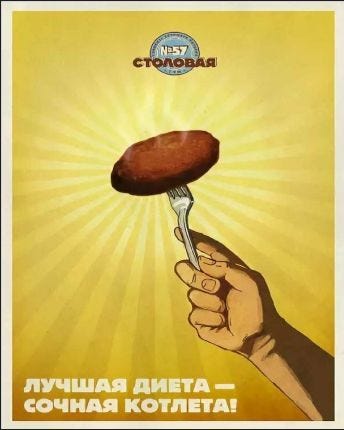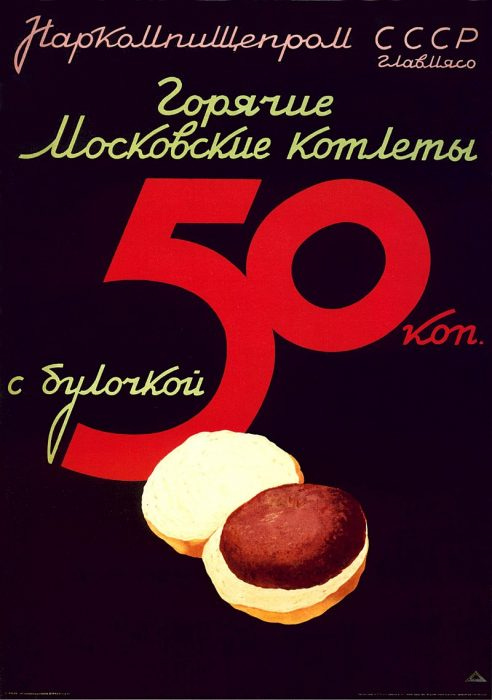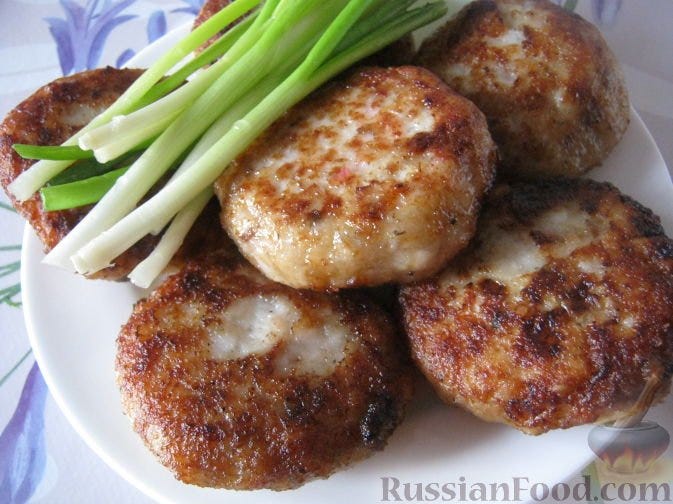America, we need to have a talk. It won't be a pleasant one, but it needs to happen. I will lay it out to you bluntly, just ripping that band-aid right off. Thing is, America, you are atrociously bad at hamburgers. There, I have said it. Let that ham steam a little...
I take no pleasure in saying this, but, listen, after six posts of letting you laugh at the trials, tribulations and outright absurdities of the Soviet (and especially Russian) culinary journey, Eastern Europe deserves to strike back, even if just once. (Warning: it shall strike more than once.)
Here is another thing. We, the proud survivors of Eastern European cuisine, are painfully aware that the American hamburger, while sorely inadequate for all the reasons that will be outlined in exhaustive detail below, is nevertheless conquering the world. It is all the rage in Europe, in the Far East and, of course, in Russia where it has absolutely no reason to thrive yet does anyway, somehow, despite all the Western fast food chains’ having fled in justifiable horror after the 2022 invasion of Ukraine.
Yes, I have walked the streets of Chelyabinsk gazing in disbelief at the enormous billboards imploring the hardy denizens of the Urals to eat a particular brand of "gamburgery", the graphic showcasing said monstrous "gamburgery" in all their ketchup-slathered shame. Yes, I have listened to horrible Russian rap songs imploring Moscow's citizens to "down a burger for the health" of the city's glorious and perfect mayor for ridding it of gays and protestors. If any other prove of modern Russia’s being pure evil was needed, here it is.
But here is the thing. The hamburger sits on a throne of lies. Deep in your hearts and even deeper in your stomachs you know that its fame is as shallow as its substance. That its worldwide acclaim is as manufactured as the McRib hype. That ultimately, at its basest level, the hamburger tastes of nothing, represents nothing, amounts to nothing and is craved by nobody. Just like regulation-free economy.
The hamburger, after all, is nothing but a handful of ground beef-like matter shaped into a flat hockey puck, with a bit of salt and pepper added purely for ceremonial reasons, and mercilessly scorched. The hamburger's own, native taste roughly resembles that of an ancient, decomposing shoe sole. Its only value is to deliver protein to a meal otherwise composed of bread, cheese, lettuce, tomatoes, several brightly-painted snot-like condiment matters, mushrooms, pickles, bacon, onions and whatever the hell else you throw into that abominable cauldron of culinary failure. The need to stockpile ingredients in between two limp, criminally tasteless pieces of bread is there precisely because the hamburger itself is such an empty vessel. It's mutilated body parts a cow had given up on. It's less than worthless. Its worth is measured in negative numbers. It's death in patty form.
It's fine and good to criticize our ways of treating minced beef trimmings, you will say. But hey, you will add, don't act like Eastern Europe, of all places, has figured a better way to make them edible!
Well, funny that you ask...
The Picture
The kotleta is the alpha and omega of Soviet cooking. It's the perfect nexus of means and abilities that has produced an unimpeachably great result, a pinnacle of its genre, absolutely unreachable by any Western analog. It is the standard your "steamed hams" will never approach, no matter how much ketchup you pour on them or what type of bread prison you encase them in.
Here is the thing you should know about the kotleta. It is the one Soviet dish that keeps our American-born kids firmly tethered to their roots. They will gobble peanut butter and squeal for chicken nuggets and categorically reject our beloved staples such as borscht, black bread and all mayonnaise everything, but a mere whiff of a kotleta will make them drop all veneer of Yankeeness and beg for it in perfect, unaccented Pushkin's Russian, Shevchenko’s Ukrainian or even whoever the hell spoke Belarusian at some point in history.
For no human being who has sampled the kotleta can ever return to hamburgers as if no life-transforming event had just occurred. Nobody can keep living pretending that those things, those ketchup-slathered corpse mounds of wasted food are OK. You can always tell an American-born child of Soviet-born parents by the sad, condescending look their faces assume anywhere in the vicinity of an American burger joint. "How can this occupy the same universe with mom's kotleta?", this look implores. And, like so many eternal questions posed by Dostoyevsky, it has no satisfactory answer. A species that has invented the kotleta should never have also invented a hamburger. Or concentration camps, for that matter. But hey, humans are fucked up, what can we say?

The Terminology
With all that said, let's talk a bit about the linguistics of the matter. The Russian and Ukrainian term kotleta, as can easily be surmised, is nothing but the Russification of the English/French word "cutlet", though the actual dish bears no resemblance to the word's meaning. The cutlet is, of course, a specific cut of meat, usually quite thin, which is mostly served fried and quite often breaded. In Russian, this dish is referred to as "otbivnaya kotleta" (literally, "beaten cutlet") and is not in any major way different from anything you know as a "cutlet", or a “schnitzel” for that matter.
The actual kotleta, however, was a variety made for people who couldn't easily afford high-quality meat. As such, it was a cutlet-shaped patty of ground meat, originally dubbed "rublenaya kotleta" (or "minced cutlet"), but the first word was later dropped as in the Soviet Union it quickly became, for obvious reasons, the only kotleta available to most of the population most of the time. The word "croquette" would probably be slightly more fitting here, but who cares, because we have taken this rather pedestrian peasant dish and perfected it in the way that gives it every right to call itself whatever the hell it wants.
Interestingly enough, during the Soviet era, Stalin's Trade Minister Anastas Mikoyan, whom I have already mentioned several times in my narrative, attempted to introduce the American hamburger to the Soviet populace, resulting in a dish that was called "Mikoyan's kotleta." However, it quickly lost its inherently unequal competition with the already gloriously successful dish.
The classic "mom's kotleta" is prepared in many varieties, and I will not hyperbolize in the slightest when saying that its main ingredient is love. Unlike the hamburger which is prepared by heartless machinery that will one day assuredly exterminate us all, the kotleta can only be hand-shaped, with ingredients measured out and mixed with utmost affection and devotion. Indeed, the only way to make a kotleta bad is to extinguish all traces of goodwill and hope in your heart.
The Process
What you will need for a kotleta is, of course, ground meat. It doesn't matter which animal it comes from, for a good kotleta can be made out of beef, chicken, veal, pork, turkey, mutton or a mixture of any of the above. But while this is the only ingredient of a hamburger, the point at which America has decided to stop and declare "My work here is done!", meat is but the beginning of the kotleta's spiritual and material journey into the ranks of culinary bodhisattvas.
Absolutely imperative for kotleta's genesis is onion. Remember, America, while you can absolutely make sour cream without fat or hot dogs without dog, making a ground meat patty without onions violates all laws of humanity and physics and should be equated to war crimes and blasphemy. For if you endeavor to skip on the onions, why would you even bother with anything else? Just gnaw your meat raw while grunting and spluttering as your intellectual equals in the sty or the gutter would do.
It seems that lately Americans have gotten some dim, distant notions of this indisputable fact, as is evidenced by the recent “smashburger” fad, but here, yet again, you present a rather pitiful picture of a savage trying to crudely imitate delicate artwork with his own primitive stone tools. Watching you attempting to incorporate onion into your patty by literally smashing the two objects together brings nothing but tears of pure grief to my disbelieving eyes. This is like attempting to make a baby by putting a man and a woman in a car together and driving it into a concrete wall at 100 mph. What you get is two intermingled corpses, not a new life form, people! Here is how to do it properly.
A humble yellow cooking onion will absolutely do, about one of a medium size per pound of meat. It must be put through a meat grinder or a food processor in order to turn it into a semi-liquid gruel-like substance and release its precious juices. Then, carefully and lovingly, mix the onion into the meat until they combine in perfect symphony with each other. You can leave smashing where it belongs: in demolition derbies and the Marvel Cinematic Universe.
Now, while onion is absolutely irreplaceable, garlic is strictly optional, but many kotleta crafters do like to add a minced clove or two per pound of meat into their creation. Feel free to do the same. Nobody has ever regretted doing so.
Meat and onion form the basis of your creation, but, like everything we build, a binding agent is needed, and in a proper kotleta such a binding agent is bread.
An Interlude - The Gotcha Moment
"WAIT! STOP! KILL THE MUSIC!", you shall scream at this point. Surely, you are about to shout obscenities in my face while declaring that I am describing the creation of a meatloaf and in no way a better alternative to hamburgers.
Shut your mouth.
Do not dare say such words in my presence again. Now, sit down and keep reading while appreciating my willingness to let you continue living after uttering such horrible slander.
Yes, the reason your hamburgers are so severely lackluster is because you have gravely misunderstood their ancient, most essential secret: the bread must go inside the patty, filling its existence with meaning and inner light, not encase its mutilated corpse on the outside, serving as nothing but a coffin for its wasted potential. As always, the shallow and materialist West is vainly grasping for the truth on the surface while neglecting to penetrate the deeper meaning.
Consider yourself chastised. We shall continue.
The Process (continued)
Yes, bread is imperative for creating the proper kotleta, but it must be treated in accordance with the dish's god-like status. Pieces of white bread (a couple of slices per pound of meat will do) must be soaked in milk, just enough of it to be absorbed, and then ground up into the meat-and-onion mixture. As you carefully and lovingly (and I can’t overstate the importance of love, since it’s one of its very few applications in everyday Soviet love) mix it all together, you should be able to feel the smoothness, the vitality, the bursts of possibility emanating from your masterpiece.
And yet we are not quite done! Another binding agent, not mandatory yet helpful, is an egg (one per pound of meat), which will make certain that your patty keeps its structural integrity even if you slightly overdid it in the milk department or if your onion wound up being a little too juicy.
Then, come the absolute essentials: salt, pepper and spices. A true Level 800 Soviet cook will settle for nothing less than khmeli suneli, a Georgian mix of herbs, where coriander, fenugreek, parsley and (obviously) dill play the leading roles, but you are welcome to do you and choose whatever herb and/or spice mix floats your particular boat. On this issue, we do not tend to be purists and, rest assured, whatever you choose, it will still be much preferable to scorching your meat on the grill and dousing it in cold ketchup later.
You have almost reached valhalla, friend. Your mixture is ready to be hand-shaped into the glorious Communist patty. No great skill is needed here other than imagining you are caressing the man or woman of your dreams in the most intimate and tender moments of your relationship.
Of course, some true masters of the art go the extra mile and shape them in a way that insures a hollow space inside that will fill with meat juices upon cooking, creating a pocket of meat broth that will penetrate the kotleta's tender flesh and explode in your mouth obliterating all thoughts of McDonalds from your memory forever.
Once the patties are formed, you must, and I can't stress this enough, MUST roll each in flour or breadcrumbs, for while there is nothing wrong with a naked kotleta, one with a succulent golden crust that offers a measure of protection for the mystery inside is truly on another level.
The kotletas are then fried in vegetable oil, for a few minutes per side, until the crust is golden-brown and the flesh inside is faintly pink. This is it. You have finished your kotletas, you have made the world an incrementally better place to live in.
The Consumption
Under no circumstances shall you:
encase the kotleta in a bun or a bread vessel of any kind
pour ketchup on it or indeed bring it within a half-mile radius of the kotleta
use your grubby misshapen paws to eat it.
The kotleta must be consumed with a fork and accompanied by mashed potatoes or buckwheat porridge or pasta or anything else that strikes your fancy as a good, wholesome side dish. Sure, fuck it, do it with French fries, why the hell not.
Kotletas are also the preferred vodka chaser of anyone who has ever tried it in such capacity, as all true intellectuals know that only peasants chase their vodka with cold appetizers.
The Varieties
"Mom's kotleta" isn't the only version of the dish available to a discerning connoisseur of minced-meat dishes. Over the centuries, enterprising minced meat artisans have come up with a multitude of different ways to prepare their superior hamburgers. And though none of them exactly top the basic recipe (for how can one hope to top perfection itself?), they do offer a little bit of variety and space for creativity. Here are but a few of "mom's kotleta's" little children.
Pozharsky kotleta. This rather aristocratic version is named after the Pozharsky Inn in Moscow and is mentioned in a poem by Alexander Pushkin himself. The original recipe called for the use of veal but the modern version is usually prepared with ground chicken. The bread is usually soaked in cream and melted butter is added to the mixture. The onion, instead of being put through the grinder, is finely minced and lightly sautéed in butter. Additionally, instead of being rolled in bread crumbs, it is covered in white bread croutons prior to frying.All and all, the Pozharsky cutlet takes the basic recipe and dials the decadence up a few notches, creating an extremely juicy and tender outcome. It is a highly treasured dish in swanky restaurants, but it’s easily created at home by anyone with hedonistic inclinations.
Poltava kotleta. Poltava is a city in Ukraine, which in and of itself should immediately tell you the secret ingredient of this dish. It's bacon fat, of course! Finely minced fat is added to the meat mixture (the meat itself is normally beef) and the rest of the recipe stays the same, except for the bread which is rendered unnecessary as the fat fulfills the duties of the binding agent rather admirably. The addition of bacon fat, which renders into the meat, makes the patty criminally tasty and almost immediately lethal, but what's an artery or two when the world is burning around us anyway?
Kotleta Kyiv-style. This is nothing other than Chicken Kiev, which is not a kotleta at all, but rather breaded chicken breast with butter inside. While delicious in its own way, it does not belong in the same family, yet is often mentioned as a kotleta variety, including on restaurant menus. Buyer beware.
Khlynov kotleta. This is the original name of the Russian city of Kirov, and the secret ingredient here is minced raw potato. This is a slightly cheaper and less fatty way of making the patty juicier while also giving it a bit of starchy firmness. A more obscure recipe, yet still found in the Russian backwater and certainly not without its merits.
Oryol kotleta. Another one named after a city in central Russia, this version is exactly the same as the classic, but offers one extravagant flourish: cream is added to the pan during the frying process to make the product juicier and more luxurious. I would definitely recommend omitting milk-soaked bread as the binder for this recipe, as a generous helping of bread crumbs will probably do.
This is not an exhaustive list by any means. The full account would have to include “fish kotletas” (which vary between what is basically a fishcake and a slightly less bland version of gefilte), Moscow-style kotletas (which are rolled in sesame seeds instead of bread crumbs, because everything Muscovites do is needlessly extravagant, include grated potato as the binder and must have a piece of butter inside each patty) and other, more obscure varieties.
But generally, this is it. You have now been properly educated in the way of the true hamburger. You can go in peace and spread the gospel further. But don't forget to come back soon, for the next installation of my series. Most of which, I suspect, will after all contain culinary horrors rather than food for enlightenment.













Hysterical and something I will try at home. The recipe seems like a peek into the mysterious russian soul.
Have you not just described the Salisbury steak? An item which Americans have also, with much glee, turned into an abomination